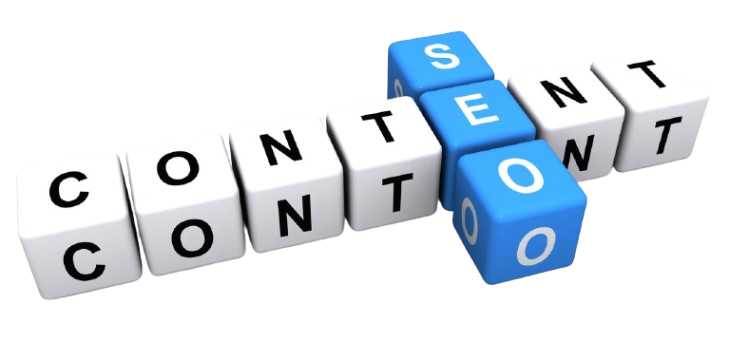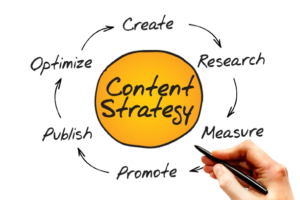The foundation of a successful SEO content strategy in the broad field of search engine optimization (SEO) is knowing and prioritizing user intent. Customizing your content to your audience’s preferences and needs is more important than ever as we go into 2025. Tracking rankings, algorithms, and keyword stuffing may easily lead to distractions. The reality is that consumers, not rankings, are what pay the bills. If your SEO material doesn’t address the demands of actual people, you’re falling short.
So, how do you make sure your SEO content strategy is on point in 2025? It all comes down to one key factor – user intent. How can you create content that truly meets your audience’s needs? In this blog, we’ll share simple strategies for crafting optimized content that not only ranks well but also connects with your readers. With the help of the best digital marketing agency, you can boost your digital presence to be both impactful and insightful.

What is SEO Content Strategy?
SEO content strategy focuses on creating and refining content to increase the ranking and ranks of your website in search engine results pages (SERPs). Like a road map, it helps you create content that is relevant to your audience and friendly to search engines. It aligns your work with your SEO goals.
Let’s get right to the point: companies looking to improve their online visibility and attract more natural visitors must have a strong SEO content plan. Most internet searches start with a search engine query. So, it’s smart to create content that ranks well for relevant keywords. This strategy helps businesses in several ways. They increase their visibility, connect with a larger audience, and draw in more quality leads to their websites.

Businesses benefit from a successful SEO content strategy:
- Boost search visibility: High-quality, keyword-optimized content improves rankings for relevant searches, helping potential customers discover you online more easily.
- Boost organic traffic: More clicks from search results come from better search rankings, increasing traffic to your website.
- Boost user engagement: Offer helpful, educational content that meets your audience’s needs. This keeps users interested and encourages them to spend more time on your website.
- Increase conversion rates: Higher conversion rates, whether for purchases, form completion, or email subscriptions. This can result from content that successfully leads your audience through their path.
To get your SEO content strategy right, create content that connects with your audience while also ranking well on search engines. This includes doing keyword research, using SEO reseller services, and writing valuable, high-quality content. Follow on-page SEO best practices to drive the best results!
A solid SEO content strategy can improve your online presence. It can also attract more targeted visitors and boost your digital marketing results. This is particularly important for B2B businesses using content marketing to generate high-quality leads and develop thought leadership. At Mount Web Technologies, we also offer B2B marketing that takes your business to new heights. Connect with our experts today!
Understanding User Intent in SEO Content Strategy
Understanding how SEO principles and user intent interact is important before developing a successful content strategy. Each enhances the others, making your content more useful and visible. User intent reveals the reason behind every search query. Whether someone searches for “affordable web design” or “tips for increasing website traffic,” their intent determines the type of content that will meet their needs. Understanding and aligning with this intent is key to creating content that attracts and converts.
User intent usually divided into three primary categories:
Informational: Users look for solutions or gain knowledge about a subject. For instance, a prospective customer may look up “What is local SEO?” to learn more about how local SEO services may raise their company’s profile. Another example is “How to improve website speed for SEO,” which suggests an interest in technical SEO information.
Navigational: Users search for a specific brand or service. For example, someone looking for a “white label SEO reseller” or “top digital marketing agency” wants to learn more about that company or visit their website. Understanding this intent helps businesses attract the right audience.
Transactional: Users are ready to take action, whether hiring a service or purchasing. For example, searches like “SEO reseller service near me” or “hire a digital marketing agency for e-commerce SEO” show they are looking for a trusted provider. This is the perfect time for businesses like The Ad Firm to connect with potential clients.
Businesses may engage people at different intent phases by customizing their content to fit each objective. Creating valuable content can build authority. This includes blog posts on the benefits of ethical SEO and guides for making engaging PPC ads.
Regarding navigational intent, ensuring our website is user-friendly and maximizing branded keywords guarantees that consumers will discover what they need fast. Lastly, creating custom landing pages with strong calls to action and testimonials builds trust. This helps turn visitors into customers for buying purposes.
How to Implement an SEO Content Strategy for User Intent
Below, we break down the steps to creating an SEO content strategy that matches user intent, helping you attract more visitors and boost conversions.
1. Establishing a Solid Research Foundation
The first step in building a strong foundation is thorough research. With a comprehensive grasp of user behavior and keyword analytics, organizations can produce content that appeals to their audience and performs well in search results.
Performing Keyword Research with User Intent in Focus

Keyword research is key for both SEO and local SEO. But it’s not just about finding popular keywords – it’s about matching them to user intent for better engagement.
Key steps for effective keyword research:
- Know Your Audience: Recognize your audience’s needs at every stage of their journey.
- Examine Search Intent: Assess whether a keyword serves an informational, navigational, or transactional purpose.
- Utilize Advanced Tools: Take advantage of tools such as Google Keyword Planner, Ahrefs, and SEMrush to discover new opportunities.
For example, keywords like “SEO reseller service” focus on transactional intent, while phrases like “how to optimize content for search engines” cater to informational intent.
Understanding Search Patterns and Trends
Choosing keywords is only as important as knowing how consumers search. Analyze queries for trends and patterns to better predict user requirements. Utilize resources like Google Trends and Search Console to learn about new themes and seasonal changes relevant to your audience. By blending this analysis with specific keywords, companies can make sure their content stays engaging and on point.
2. Creating Content That Balances SEO and User Intent
Every piece of content you produce should have a clear goal, such as converting, educating, or directing. Unfocused content can create noise. On the other hand, targeted and intent-driven topics are beneficial for both consumers and search engines.
Selecting the Right Topics

Choosing the right content themes is key. They help grab readers’ interest, build credibility, and boost SEO goals. Take into account these tactics to find issues that have an impact:
- Target User Pain Points: Understand the common issues that your audience has and provide content that directly addresses them. For instance, queries like “Why isn’t my website ranking?” can lead to a piece that tackles issues such as poor keyword targeting, weak content strategies, or ineffective technical SEO. This method teaches and shows that you are skilled at resolving actual issues.
- Break down complicated choices: Content that helps users make smart choices builds trust and makes you a go-to source. A blog titled “Tips for Finding the Right White Label SEO Reseller” can showcase important factors. These include expertise, success stories, and transparency.
- Highlight skills to gain trust: Show your expertise with detailed content like case studies, step-by-step guides, and expert insights. For example, a blog post like “How White Label SEO Reseller Services Help Agencies Grow” can offer valuable tips and build trust in your industry.
Make your themes engaging and relevant by answering these questions. Also, tailor your content to fit your audience’s needs. This approach will give readers a clear and purposeful path.
Developing Content That Addresses User Needs
The best content is made to address certain problems that your target audience encounters. Here’s how to create content that solves problems and connects:
- Use Data and Research: Back up your points with real data to build trust. For example, share results from professional SEO services showing how businesses improved their rankings or sales. Use industry stats that match your audience’s needs to make your content more convincing and useful.
- Make it Actionable: Give your audience useful, detailed guidance to empower them. For example, a blog article, “5 Simple Ways to Boost Website Traffic,” may cover tactics like developing backlinks from local sources. Also, improving Google Business Profiles, and producing content tailored to the local area. This guarantees that readers will feel knowledgeable and ready to take action after reading your content.
- Connect with Your Audience: Always relate your knowledge to the particular requirements of your audience. For example, share success stories from the industry. Use examples that are specific to a location if local companies want local SEO services. This type of content captures readers’ attention and strengthens your relationship with them.
Stick to these guidelines, and your content can solve audience problems. This will also position your company as a dependable source in digital marketing.
Effective Content Formats
Whatever the audience’s journey, giving them various content formats that match their goals helps them find the information they seek. Here are a few examples of successful content formats:
- Informational Content: This content includes blog posts, FAQs, and detailed guides that help educate and inform your audience.
- Navigational Content: Create focused landing pages to help users quickly find what they need.
- Transactional Content: Use content to build trust and drive action. Share success stories from satisfied clients, customer reviews, or detailed service pages. This shows your expertise and helps to convince potential customers to choose you.
Choose and use different content types to meet user needs at every stage. This helps educate, guide, and convert them into loyal customers.
3. Enhancing On-Page SEO Elements
Making interesting material is only half the fight. On-page SEO is crucial if you want your efforts to be effective. With this method, search engines can understand your material in addition to users.
Crafting Engaging Headings and Subheadings
Headings that are clear and descriptive help readers navigate your information and make it easier to read. When creating headings:
- Use Relevant Keywords: Naturally include key terms in headings to improve search visibility. For instance, a title like “How Local SEO Helps Small Businesses Thrive” directly addresses user intent.
- Organize Content Effectively: Divide information into clear sections to improve readability and engagement.
- Use Clear Headings: Choose simple titles that clearly show the topic. This helps readers understand right away.
The context of your material is determined by search engines using headers, so careful planning is essential.
Writing Captivating Meta Descriptions
Meta descriptions are vital for your SEO strategy. They create the first impression of your content in search results. Use these excellent strategies to create captivating meta descriptions:
Keep It Short and Clear: Meta descriptions should be between 150 and 160 characters. This range helps them show up well in search results. Avoid unnecessary words and focus on the key message. A page on SEO reseller services could use a meta description like: “Boost your agency with top-notch SEO reseller solutions.” Get white-label services that drive results!”
Use a Strong Call-to-Action (CTA): A CTA encourages users to engage. For example, a blog on digital marketing strategies could include: “Boost your revenue with top-notch SEO reseller services. Partner with us today!” This approach informs users and prompts them to take action.
Match User Needs with Relevant Solutions: Ensure your meta description aligns with the page’s goal. If it’s about outsourcing SEO, try: “Scale your business effortlessly with SEO reseller solutions tailored to your agency’s success.” This speaks directly to businesses looking for expert support.
Using Internal Links to Boost Engagement
Your site’s internal connections let visitors discover relevant material. Among the successful connection techniques are:
- Linking to Relevant Pages: Include links to service pages, such as “Expert SEO Reseller Solutions,” in related blog posts for added value.
- Streamlining User Navigation: Guide visitors to key pages like contact forms and success stories. This helps them take action more easily.
- Improving SEO: Internal links help search engines understand your site’s layout. They also ensure link authority flows smoothly.
Other Important On-Page Elements
To improve the performance of your content, optimize the following components:
- Image Descriptions: Create simple and relevant alt text for images. Include terms like “SEO reseller services” to improve accessibility and boost SEO.
- Optimized URLs: Use simple and clear URLs like “yourwebsite.com/seo-reseller-experts.” This helps with readability and boosts search visibility.
- Faster Page Speed: Make sure your pages load quickly. This improves user experience and reduces bounce rates, which can boost your search rankings.
4. Measure, Adapt, and Keep Improving
SEO content strategy is an ongoing process, not a one-time task. Continuously track important metrics like bounce rates, click-through rates, and conversions to assess performance. Update and refine your content to stay relevant, meet user needs, and align with search engine trends. Consistent optimization ensures long-term success in SEO.
Elevate Your SEO Content Strategy with Mount Web Technologies
In 2025, SEO is about more than just keywords. Creating content that connects with your audience and matches their search intent leads to higher rankings and better engagement. By focusing on user needs and continuously refining your approach, you can stay ahead of the competition.
As your white label SEO partner, Mount Web Technologies helps you develop an effective SEO content strategy that enhances visibility and drives growth. We craft data-driven, intent-focused content that makes your brand stand out. Get in touch with our experts today.


